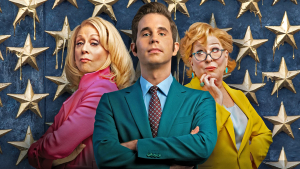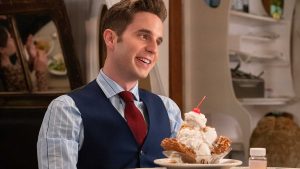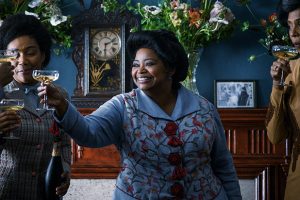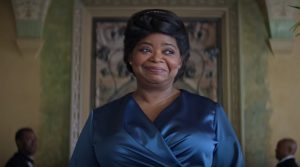Is 2015’s Carol a Christmas movie, in the proper sense of the phrase? Some would argue it is simply by virtue of being set in the last few weeks of December (and because one of the most memorable scenes in the movie revolves around the subject of Christmas presents), but in my opinion, it’s even a bit deeper than that.

Carol utilizes Christmas for more than just pretty set dressing. The overwhelming noise and chaotic hustle of the holiday season provides the perfect backdrop to the quiet, intimate, love story at the film’s core. The crowds of confused and hurried shoppers rushing to find gifts is an unmistakable parallel to the confusion of any whirlwind romance, but particularly one shared by two women in an unaccepting era – when even the terminology for sexual orientation was still unclear and mostly derogatory. And Christmas brings with it a whole slew of constraints and restrictions on the time our heroines can spend together without being watched. But…whenever the romance finally has a moment to breathe, everything goes quiet. The noise dies down until it’s little more than a murmur in the background; Carter Burwell’s Oscar-nominated score gently reinforces the building passion; and the spirit of Christmas is discovered in simple things like snowfall on a terrace at night, a Christmas tree purchased on the spur of the moment, or an abrupt winter getaway out west.
Based on The Price Of Salt (a semi-autobiographical novel first published in 1952 by Patricia Highsmith under a pseudonym and later republished in 1990 as Carol under her real name), Carol remains a milestone in LGBTQ+ representation in film: the movie that launched a thousand awards-friendly atmospheric period dramas about introspective white lesbians. The story is small-scale on the surface – a series of electric interactions between two women that quickly becomes a fling, and then a romance – but the stakes couldn’t be higher for either character: Carol Aird (Cate Blanchett) is at risk of losing custody of her daughter if her sexuality is discovered, while Therese Belivet (Rooney Mara) is already engaged to a man for whom she has no feelings. The chemistry between the two actresses is the primary reason for why the movie works as well as it does, and for why it feels so genuine and impactful.

Carol, the mysterious, multi-faceted woman around whom the story revolves, is the older and wiser of the two; but while her years have given her a flippant attitude towards life and a steady, self-assured command over herself, her surroundings, and her sexuality, they haven’t quieted her desire to finally live freely. Blanchett owns the role like a revelation wrapped up in an epiphany and a sensuous mink coat. And what’s brilliant about Blanchett’s performance (here and elsewhere) is that she never feels the need to overdo anything. Every one of her movements, mannerisms, facial expressions, winks, and subtle half-smiles is loaded with purpose – but so casually conveyed that Blanchett never comes off as fishing for Oscars. Oftentimes, the philosophical dialogue spouted in dramas can come off as inorganic and bizarrely forced, but Blanchett’s line-readings, delivered in that famously deep register that she might as well trademark, are equal halves relatable and enchanting.
The strength of Mara’s performance is in how clearly and vividly she expresses her love for Carol. While the extent of Carol’s feelings toward Therese Belivet are necessarily mysterious and unclear until the very end of the film (and Blanchett easily sells that aura of mystery, where you never know if something she’s said has a double entendre or a hidden meaning), the entire story hinges on Therese’s immediate attraction to Carol. It sounds quite simple – Cate Blanchett is a magnetic personality, after all – but Mara succeeds at convincing us that Therese’s devotion goes deeper than a surface-level. And although the film can’t take us into Therese’s head like the novel, it gets as close as it possibly can. Director Todd Haynes stages each romantic scene as if from Therese’s point of view, as she absorbs every tiny detail about her lover. That subtly allows us to also learn about Therese’s own self-doubt, which prevents her from recognizing her own worth until much later in the film, when the tables are turned.
Alongside powerhouse talents like Blanchett and Mara, it’s hard for anyone else in the movie to carve out much space for themselves. Sarah Paulson comes closest, playing Blanchett’s former lover Abby. Paulson, herself one of the most prominent LGBTQ+ actresses in Hollywood (and whose wife, Holland Taylor, was one of the most prominent LGBTQ+ actresses in Hollywood), has a key supporting role, holding her own opposite Blanchett as the latter’s foil. Also, her ability to slay in brown plaid is admirable, and I would totally watch the Carol prequel Paulson wants to make.
Behind the scenes, pretty much everybody deserves some measure of praise, because the film is a technical masterpiece: but I would especially point out Carter Burwell, whose score beautifully compliments the action; costume designer Sandy Powell, the mastermind behind Carol’s assortment of fur coats, headscarves, and sundresses; and cinematographer Edward Lachman, whose decision to shoot in grainy 16mm film is a large part of why the entire film feels so engrossing.

But the key to Carol‘s success and popularity (and something which many of its predecessors and successors have forgotten or ignored) is its happy ending, something that stunned readers back in 1952 and viewers in 2015. Little has changed between those two dates, if a simple happy ending is still perceived as groundbreaking in stories (particularly romances) about LGBTQ+ characters, and too little has changed even in the five years since Carol came out. But onscreen representation matters: it has the power to uplift and to inspire. And that’s exactly what Carol‘s ending did for many viewers, by promising something better. Even if it’s not a traditional Christmas movie, it invokes the true spirit of the season far better than some.
Movie Rating: 9.5/10








